Išpuini and Minua (A 3 and B 3)
Among the texts mentioning the deeds of Išpuini and his son Minua are records of their joint military campaigns and building inscriptions, some of which contain instructions for the performance of offering rituals. The longest and most remarkable building inscription that also incorporates ritual offering instructions is engraved in a rock niche in an open-air sanctuary at Meher Kapısı, near Van (A 3-1). The text specifies the kind, and number, of sacrifices to be offered to various Urartian deities in the "Month of the Sun-God." By naming more than 80 deities in hierarchical order, the text provides an illuminating insight into Urartian religion (for further information see the section below "Religion").
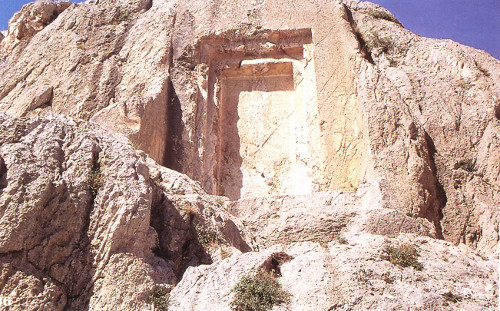
The rock niche in the open air sanctuary at Meher Meher Kapısı near Van, photo: Oktay Belli (1999): The Anzaf Fortresses and the Gods of Urartu, İstanbul: plate 36.
Furthermore, Išpuini and Minua authored a votive inscription on a bronze shield, found in Yukarı Anzaf. The shield is beautifully decorated with a battle scene which shows twelve Urartian deities marching against the Assyrian army and defeating it (B 3-1). The shield is of great importance for research since it provides information about the appearance of some of the Urartian deities. With the help of the Meher Kapısı inscription, and on the basis of their outward appearance, at least some of them can be identified as specific deities (for further information see below "Religion").

Fragment of the bronze shield from Yukarı Anzaf with a depiction of Urartian deities defeating the Assyrian army, photo: Oktay Belli (1999): The Anzaf Fortresses and the Gods of Urartu, İstanbul: plate 46.
Like the inscriptions that describe the deeds accomplished by Išpuini alone (A 02), most of the inscriptions recording the joint undertakings of Išpuini and Minua (A 3) are written in the Urartian language. The only exception is the famous, extensive Urartian-Assyrian bilingual stele inscription (A 3-11), originally located at the Kelišin pass at the border of modern Iraq and Iran. It reports a journey made by Išpuini and Minua to the main sanctuary of the god Haldi in the city Ardini, which was located in the state of the same name. In Assyrian, both the city and state were called Muṣaṣir. Despite the great importance of Muṣaṣir and Haldi's main sanctuary for the Urartian kings, Ardini/Muṣaṣir remained an independent state.
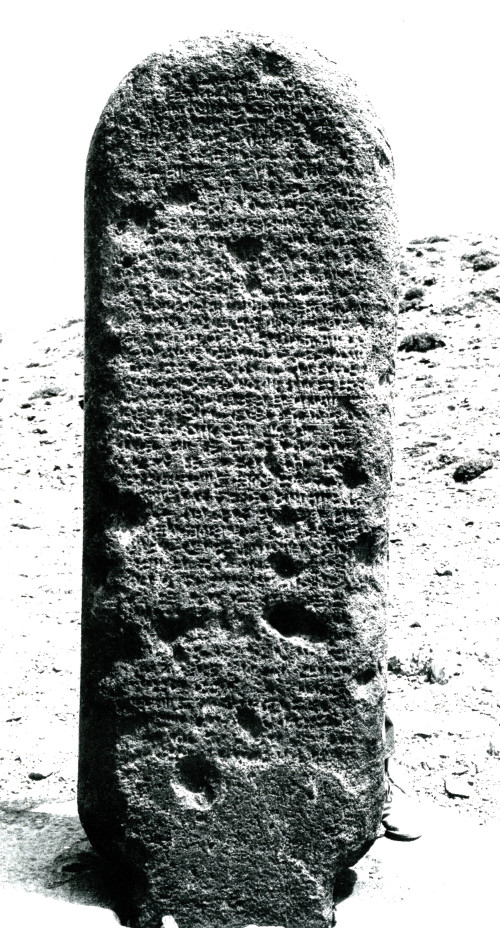
Stele from Kelišin with the Urartian-Assyrian bilingual inscription of Išpuini and Minua (A 3-11) recording their journey to the main sanctuary of the god Haldi in the city of Ardini (Assyrian Muṣaṣir). The photo shows the reverse side of the stele, with the Assyrian version of the text. Photo: Paolo Emilio Pecorella (1976) in: Mirjo Salvini, CTU III: 90.
On the basis of the military records reporting joint expeditions made by Išpuini and Minua, it has been assumed that in his later years Išpuini ruled alongside his son Minua (see, e.g. Salvini 1995: 48). It should, however, be noted that in most of the inscriptions neither Išpuini's nor Minua's name is accompanied by royal titles. In the few exceptions to this, only Išpuini is referred to as king. Therefore, it is more likely that Minua accompanied his father on these various campaigns as the crown prince, as is also attested for Rusa, son of Sarduri, and his son and crown prince Melarṭua. The same probably holds true for Išpuini and Minua's joint building projects.
Among the inscriptions mentioning the joint deeds of Išpuini and Minua are the first Urartian inscriptions bearing curse formulae for the protection of the inscription and the work of the respective ruler(s) (see A 3-4 and A 3-11). Minua and his successors kept this tradition.
|
Išpuini / ass. Ušpina Synchronism: approx. 820 BC = 2nd campaign of Šamšī-Adad V |
|
|
Assyrian Sources |
|
|
RIMA 3 A.0.103.1 ii 16b-34a: 2nd campaign led by the chief eunuch Muṭarris-Aššur to the land Nairi where he conquered 11 fortified cities as well as 200 other cities of Ušpina. Minua is not mentioned in Assyrian sources. |
|
|
Urartian Sources |
|
|
1. Stone inscriptions |
|
|
CTU A 03-01: construction of a "Gate of the God Haldi," a burganani (probably a stable or pen where sacrifical animals are kept) and the planting of orchards and vineyards. |
|
|
CTU A 03-02: construction of a tower temple (susi) and establishment of the state cult (offering rituals for the Urartian pantheon, and the construction of buildings). |
|
|
CTU A 03-03: construction of a "Gate of the God Haldi." |
|
|
CTU A 03-04: military campaign against northern Transcaucasian tribes (A 03-05, CTU A 03-06, CTU A 03-07 and CTU A 03-08). |
|
|
CTU A 03-05: erection of a stele (pulusi) mentioning the military campaign against northern Transcaucasian population groups (s. CTU A 03-04, CTU A 03-06, CTU A 03-07 and CTU A 03-08). |
|
|
CTU A 03-06: rock inscription mentioning the military campaign against northern Transcaucasian population groups (CTU A 03-04, CTU A 03-05, CTU A 03-07 and CTU A 03-08); construction of a well at the site of the rock inscription. |
|
|
CTU A 03-07: military campaign against northern Transcaucasian population groups (A 03-04, A 03-05, A 03-06 and A 03-08). |
|
|
CTU A 03-08: military campaign against the cities and lands of Aniani and Arṣini; erection of a stele; establishing an offering ritual in the land Puluadi. |
|
|
CTU A 03-09: military campaign in the region of Lake Urmia focussing on the southern area with the city of Mešta in the Land Paršua; occupation of local fortresses. |
|
|
CTU A 03-10: military campaign in the region of Lake Urmia focussing on the southern area; construction of a fortress (named "Stronghold? of the God Haldi") and a "Gate of the God Haldi." |
|
|
CTU A 03-11: construction of an iarani for the god Aldi (Haldi) and a burganani; bilingual text in Assyrian and Urartian language. |
|
|
CTU A 03-12: establishing the state cult (offering rituals for the gods of the Urartian pantheon, construction of buildings). |
|
|
2. Inscriptions on metal objects |
|
|
CTU B 3-1: fragment of a bronze shield; Urartian inscription; provenience: Yukarı Anzaf |
|
|
Literature: Fuchs 2013: 136 (study and date of the 2nd campaign of Šamšī-Adad V); Salvini 1995: 34-38 |
Tab. 1 – written sources of Išpuini and Minua
Royal Titles
As has already been mentioned, royal titles are missing from most inscriptions referring to the joint deeds of Išpuini and Minua. The only exceptions are inscriptions A 3-1 (Meher Kapısı) and A 3-2 (Yeşilalıç), which are both engraved in rock niches and refer to building projects and the establishment of offering rituals. In both texts, only Išpuini's name is accompanied by any form of royal title, whereas Minua is only referred to as "Minua, son of Išpuini". In A 3-1 o 1'-4', Išpuini is called "strong king, king of the lands, king of the Bia lands, lord of Ṭušpa-City." In passage r 14-16 of the same text, he is called "great king, strong king, king of the world, king of the land Nairi, governor of Ṭušpa-City." In A 3-2 line 26, the royal titles are "strong king, great king, king of the Bia lands, lord of Ṭušpa-City."
Rock niche at Yeşilalıç with an inscription reporting the building of a tower temple by Išpuini and Minua and the establishment of an offering ritual (A 3-2). Photo: Oktay Belli (1999): The Anzaf Fortresses and the Gods of Urartu, İstanbul: plate 38.
Military activities
One of the joint campaigns undertaken by Išpuini and Minua led them to the Uiṭeru, Luša, and Katarza, northern Transcaucasian population groups, who are collectively referred to by the name "Etiu." Their settlements were located beyond the Araxes river, and the name Katarza equates to "Katarzēnē" in the texts of Ptolemaios. The fact that Išpuini's and Minua's successors also fought these people clarifies that these endeavors were little more than episodes of looting that did not result in substantial shifts in political power. Accounts of these campaigns are given in several rock inscriptions, as well as in inscriptions on stelae and stone blocks located in the vicinities of lake Van, Pirabat and Toprakkale in the north, and Ojasar-Ilandağ in the east.
A second campaign led Išpuini and Minua to the region of lake Urmia in the southeast. This campaign is of great importance for understanding the formation of the Urartian state. A record of the campaign is given on a stele which was found in Karagündüz next to Lake Erçek (A 3-9). It describes the conquest of the fertile valleys to the south of Lake Urmia. The main target of the campaign was the city Mešta in the land Paršua. Its location to the south of Lake Urmia is not indicated by the Karagündüz stele itself, but by Minua's rock inscription from Taštepe, situated to the southeast of Lake Urmia (A 5-10). This inscription refers to the location of the inscription and the fortress built by Minua in relation to the [land?] of the city Mešta (A 5-10 line 1).
Išpuini and Minua's conquest of Mešta probably corresponded with the destruction of layer IV at Tappeh Hasanlu, the most important tell in the region. The name Paršua, which is also mentioned in Assyrian inscriptions, correlates with the later country name Persia and the ethnic name "Persians." The stele inscription of Karagündüz is therefore an important source for Persian history in that it indicates the location of Persian settlements in the region of Lake Urmia at the end of the 9th century BC.
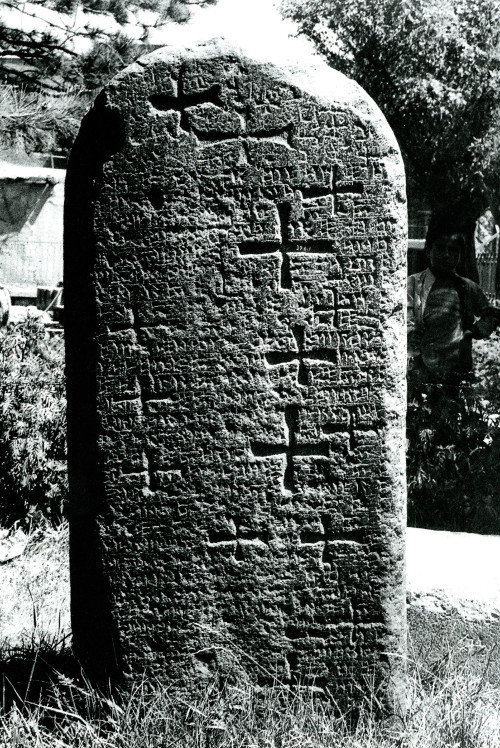
Stele found at Karagündüz, and now kept at the Museum in Van, with an inscription reporting Išpuini and Minua's military campaign to the land Paršua (A 3-9). In later times Christian crosses were carved over the inscription. Photo: Mirjo Salvini, CTU III: 84.
The annexation of the region south of Lake Urmia by Išpuini and Minua is further reflected by other textual and archaeological sources from Išpuini's reign. Among them are two inscribed objects which were erected by Išpuini and Minua in this region: one is an inscribed stone from Qualatgah that provides an account of military achievements and presumably also the construction of a "Gate of the God Haldi" in the region (A 3-10, the text is not entirely preserved). The other is a stele originally located at the Kelišin pass in the Zagros mountains whose Urartian-Assyrian bilingual inscription (A 3-11) describes a pilgrimage made by Išpuini and Minua to the main sanctuary of the god Haldi in the city Ardini (Assyrian Muṣaṣir), and the establishment of a cult dais (or, respectively, a shrine) for the god. The installation of this monument served not only to solicit the protection of the god Haldi for the Urartian dynasty, but also by the need to demonstrate their domination of the region.
Building activities
Išpuini and Minua also developed the agricultural infrastructure of previously uninhabited regions and completed a variety of building projects. The Meher Kapısı inscription (A 3-1) mentions planting orchards and vineyards, and A 3-6 from Pirabat refers to the creation of a well. Such references to agricultural infrastructure feature frequently in the inscriptions of Urartian rulers from the reign of Išpuini onwards. Among Išpuini's and Minua's building projects were several more "Gates of the God Haldi" in different locations, a burganani (probably a stable or pen where sacrifical animals were kept), an undefined building structure for the god Aldi (an alternative spelling for Haldi) called iarani, a tower temple (susi) and a fortress in the southern area of Lake Urmia.
Religion
The already mentioned Kelišin stele is of great interest for the study of Urartian religion. It was originally situated at an altitude of 3000 m on the Kelišin pass. Its inscription, which was composed in both Urartian and Assyrian versions (A 3-11), tells us about a journey undertaken by Išpuini and Minua to the city Ardini (Assyrian Muṣaṣir) and the main sanctuary of the god Haldi located there. The text also reports that Išpuini and Minua installed a cult dais (or shrine) for the god Haldi. Provided that our translation of the respective passage is correct, the dais was placed on the main street of Ardini. On the basis of this and other Išpuini inscriptions that refer to the god Haldi, and the fact that Haldi is not mentioned in the inscriptions of Sarduri I, scholars have assumed that Haldi was not elevated to the status of Urartian national god until Išpuini's reign. It must be noted, however, that only a few written records of Sarduri I have survived. Only the inscription from Sardur's castle, A 1-1, can be attributed to him with certainty, while the authorship of the fragmentary offering inscription, A 1-2, remains uncertain (see portal page Sarduri I). The fact that Haldi is not mentioned in both texts, is not sufficient proof that the god was not yet worshipped in Urartu during Sarduri's reign. Moreover, the inscription on the Kelishin stele, A 3-11, shows that the god Haldi was already venerated by Išpuini and Minua before they undertook the cult journey. Nevertheless, the aim of the cult journey was certainly to place the dynasty under the protection of Muṣaṣir and, at the same time, to proclaim their dominion over the area.
Haldi's great significance during Išpuini's and Minua's reign is further reflected by the long offering text (A 3-1) inscribed in a niche of the open-air sanctuary Meher Kapısı, near Van, mentioned earlier. The construction of this sanctuary, as well as the inscription containing a prescription for the sacrificial ritual that took place in the "month of the Sun-God," sheds light on the formation of the state cult. The text lists sacrifices that are to be offered to various deities of the Urartian pantheon in the "month of the Sun-God." More than 80 deities and hypostases of Haldi are mentioned as beneficiaries. The order in which they are listed, as well as the number and kind of animals offered to them, provides valuable information about the Urartian pantheon. The god Haldi is mentioned at the beginning of the list. He is followed by the weather god Teišeba and by Šiuini, the sun god. Several of the deities mentioned originated in regions conquered by Minua and Išpuini. The text is therefore of great importance both for the religious and political history of Urartu.
The decorated bronze shield mentioned above, which bears a votive inscription of Išpuini and Minua (B 3-1) and pictures twelve Urartian deities marching against the Assyrian army and defeating it, is also of particular interest for the study of Urartian religion. With the help of the Meher Kapısı inscription, the depicted deities can be identified as the principal gods of the Urartian pantheon.
Thus the deity at the head of the procession is, in all likelihood, Haldi. In contrast to the other deities, he does not stand on an animal, but marches on foot towards the enemy soldiers. His body is surrounded by a circle of flames. Presumably, these flames correspond to the "light of the god Haldi" (daši), mentioned in line 57 of the Meher Kapısı inscription (A 3-1) as a hypostasis of Haldi. In his left hand Haldi holds a bow, and in his right hand he holds a lance. The god wears a conical helmet, a short-sleeved tunic, a strap across his body, a belt, and bracelets on both wrists.
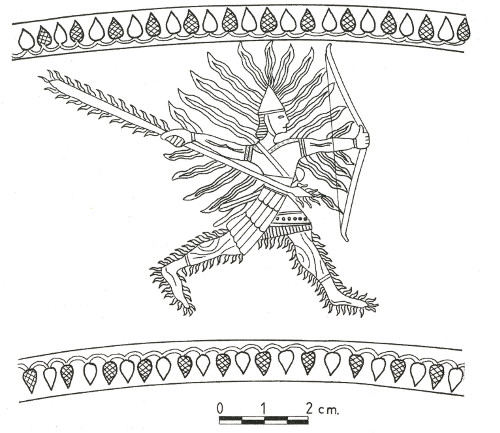
Depiction of the god Haldi on the bronze shield found in Yukarı Anzaf. Drawing: Oktay Belli (1999): The Anzaf Fortresses and the Gods of Urartu, İstanbul: Fig. 18.
The god Haldi is followed by a deity that, from its appearance, can be identified as the weather god Teišeba mentioned in line 2 of the Meher Kapısı inscription. The deity stands on a lion and holds bundles of thunder in each hand. Like the gods following him, Teišeba wears a conical helmet, a short-sleeved tunic, and a long sword.
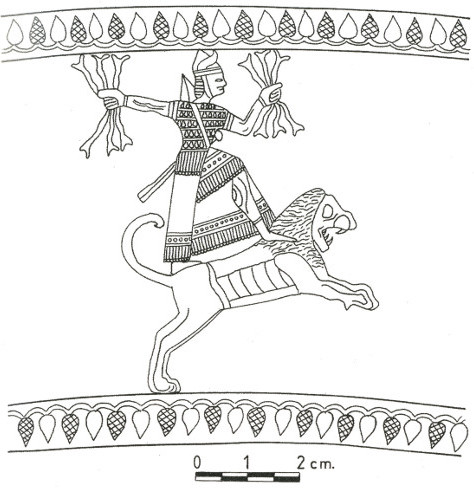
Depiction of the weather god Teišeba on the bronze shield found in Yukarı Anzaf. Drawing: Oktay Belli (1999): The Anzaf Fortresses and the Gods of Urartu, İstanbul: Fig. 19.
The god on Teišeba's left, depicted in a winged solar disc and standing on a bull, is identified as the sun god Šiuini.
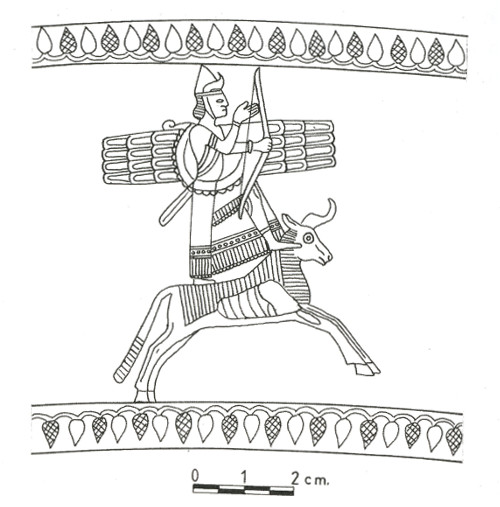
Depiction of the Sun-God Šiuini on the bronze shield found in Yukarı Anzaf. Drawing: Photo: Oktay Belli (1999): The Anzaf Fortresses and the Gods of Urartu, İstanbul: fig. 20.
On the basis of their outward appearance, as well as the sequence in which the deities in the Meher Kapısı are listed, the deities following Šiuini should presumably to be identified as the war gods Hutuini, Turani, Ua (or Ura), Nalaini, Šebitu, Arsimela (or Artu'arasau), Anapša, Dieduani, and Šelardi. All of them stand on animal-like creatures including a winged goat, ram, horse, bull or dragon, and sphinx.
Further reading
Birgit Christiansen
Birgit Christiansen, ' Išpuini and Minua (A 3 and B 3)', Electronic Corpus of Urartian Texts (eCUT) Project, The eCUT Project, a sub-project of MOCCI, 2020 [http://oracc.museum.upenn.edu/ecut/urartianrulersandtheirinscriptions/ipuiniandminuaa3andb3/]